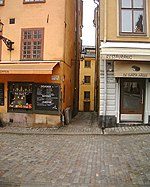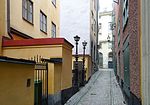Uppland Runic Inscription 53
Runestones in Uppland

Uppland Runic Inscription 53 is a runestone built into a wall in the intersection between the thoroughfares Prästgatan and Kåkbrinken in Gamla stan, the old town in central Stockholm, Sweden.
Excerpt from the Wikipedia article Uppland Runic Inscription 53 (License: CC BY-SA 3.0, Authors, Images).Uppland Runic Inscription 53
Prästgatan, Stockholm Gamla stan (Södermalms stadsdelsområde)
Geographical coordinates (GPS) Address Nearby Places Show on map
Geographical coordinates (GPS)
| Latitude | Longitude |
|---|---|
| N 59.3247 ° | E 18.0702 ° |
Address
Prästgatan 17
111 29 Stockholm, Gamla stan (Södermalms stadsdelsområde)
Sweden
Open on Google Maps











